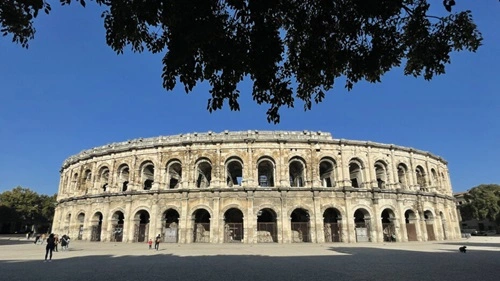The Nîmes Amphitheater, or Arènes de Nîmes, is one of the best-preserved Roman arenas in the world. Located in the city of Nîmes in southern France, this impressive structure dates back nearly 2,000 years and remains an architectural marvel, drawing visitors from around the globe. Over the centuries, it has transformed from a Roman entertainment venue into a modern cultural landmark. Here are over ten fascinating facts about the Nîmes Amphitheater that highlight its ancient roots, cultural significance, and ongoing role in the community.

1. The Nîmes Amphitheater Is Nearly 2,000 Years Old
Built around 70 AD during the reign of Emperor Augustus, the Nîmes Amphitheater is one of the oldest Roman structures still standing in France. The arena was constructed to host gladiatorial games, public executions, and other spectacles that were central to Roman culture. Remarkably well-preserved, the amphitheater stands as a testament to the engineering genius of ancient Rome and the resilience of Roman architecture.
2. It’s One of the Best-Preserved Roman Arenas in the World
The Nîmes Amphitheater is often compared to the Colosseum in Rome, but it is better preserved in many ways. This impressive arena has remained largely intact through the centuries, with much of its structure, seating, and exterior facade still visible. Its preservation is due in part to Nîmes’ relatively dry climate and the fact that the arena was continuously used for various purposes, which helped prevent decay.
3. The Amphitheater Once Held Over 24,000 Spectators
During its peak, the Nîmes Amphitheater could hold approximately 24,000 spectators, making it one of the largest arenas in the Roman Empire. The seating was arranged in tiers according to social class, with the wealthiest citizens seated closest to the arena floor. The sheer size of the arena demonstrates the importance of public entertainment in Roman society and the significance of Nîmes as a Roman settlement.
4. Gladiatorial Games Were a Main Attraction
Like many Roman arenas, the Nîmes Amphitheater was primarily used for gladiatorial games, where gladiators fought against each other or against wild animals for the entertainment of the crowd. These games were a cornerstone of Roman entertainment and showcased the empire’s military prowess. The arena also hosted animal hunts and mock naval battles, with the floor occasionally being flooded to simulate maritime conflicts.
5. The Arena Features an Ingenious Drainage System
The Nîmes Amphitheater was constructed with an advanced drainage system, which allowed water to flow out of the arena efficiently, keeping the floor dry for events. This system was crucial, especially when mock naval battles, known as naumachiae, were staged. Engineers used a combination of drains and sloping floors to keep the arena free from standing water, a remarkable feat of engineering for the time.
6. It Transformed Into a Fortress in the Middle Ages
Following the collapse of the Roman Empire, the Nîmes Amphitheater was repurposed as a fortress during the Middle Ages. In the 5th century, the arena was fortified with defensive walls and towers, providing refuge for the local population during times of conflict. Later, it became a small medieval village with homes, shops, and even two chapels constructed inside its walls. This period of transformation played a key role in preserving the structure.
7. Modern-Day Events and Festivals Bring New Life to the Arena
Today, the Nîmes Amphitheater hosts a variety of events, including concerts, festivals, and reenactments. The arena is the venue for the Feria de Nîmes, a popular annual festival featuring bullfighting, music, and parades that pay homage to the city’s Spanish influences. The amphitheater has also welcomed big-name performers like Elton John, Metallica, and Rammstein, attracting thousands of fans each year and bridging ancient history with modern culture.
8. Gladiator Reenactments Bring History to Life
One of the most unique events held at the Nîmes Amphitheater is the annual Roman Games reenactment. This historical event features live-action performances of gladiatorial games, staged battles, and displays of ancient Roman customs. Reenactors in full Roman attire bring history to life, offering spectators a glimpse into the arena’s original purpose. This experience has become a popular tourist attraction, drawing history enthusiasts from around the world.
9. The Arena Was Restored in the 19th Century
In the early 19th century, major restoration efforts began to preserve the Nîmes Amphitheater. Under the direction of French architect Auguste-Hippolyte Aubert, the arena was carefully restored to remove the remnants of medieval buildings and bring it closer to its original Roman form. These efforts marked the beginning of modern preservation techniques for historical monuments in France, ensuring the arena’s survival as a cultural and historical landmark.
10. An Architectural Wonder Inspired by the Colosseum
The design of the Nîmes Amphitheater closely resembles the Colosseum in Rome, featuring a similar elliptical shape and tiered seating. It has two levels of arcades with 60 arches on each level and is 446 feet long and 358 feet wide. This structural similarity highlights the influence of Roman architecture across the empire. Like the Colosseum, the Nîmes Amphitheater also used a complex system of corridors and staircases to facilitate crowd movement.
11. An Audio Tour Enhances the Visitor Experience
The Nîmes Amphitheater offers an audio-guided tour that enhances the visitor experience, providing historical context and detailed descriptions of the arena’s features. This audio tour walks visitors through the arena’s history, from its origins in Roman times to its transformation into a fortress and modern-day cultural landmark. For those interested in exploring at their own pace, the audio guide adds depth to the experience, making it ideal for tourists, history enthusiasts, and families.
12. A Site of Archaeological Discoveries
Archaeological excavations around the Nîmes Amphitheater have uncovered artifacts that offer insights into Roman life in ancient Gaul. Excavations have revealed tools, pottery, coins, and even gladiator remains, which help historians understand the daily lives of those who lived in and around the amphitheater. These findings contribute to a richer understanding of Roman history in southern France and the significance of Nîmes as a Roman settlement.
13. Part of the Nîmes Roman Heritage Route
The Nîmes Amphitheater is part of a larger network of Roman sites in the city of Nîmes, which includes the Maison Carrée, a Roman temple, and the Tour Magne, an ancient tower that offers panoramic views of the city. Together, these sites form the Nîmes Roman Heritage Route, an attraction that provides visitors with a comprehensive look at the city’s Roman past. This route highlights Nîmes as a vital part of the Roman Empire in Gaul.
14. It Continues to Attract Film and Television Productions
The historical and dramatic setting of the Nîmes Amphitheater has made it a popular location for film and television productions. Its authentic Roman architecture and picturesque backdrop provide a cinematic setting that has been featured in documentaries, historical dramas, and even music videos. The arena’s visual appeal and historical authenticity make it a favorite location for productions looking to capture the essence of ancient Rome.
15. Recognized as a Monument of Historical and Cultural Significance
The Nîmes Amphitheater was designated as a French historical monument in 1840 and is now recognized as one of the country’s most important cultural landmarks. Its preservation and continued use for public events reflect France’s commitment to celebrating and protecting its historical heritage. While it has not yet achieved UNESCO World Heritage status, the amphitheater remains a vital part of Nîmes’ identity and a symbol of the city’s connection to its Roman past.
Conclusion
The Nîmes Amphitheater is a striking example of Roman engineering, architectural beauty, and historical resilience. Over the centuries, it has evolved from an ancient arena of gladiatorial combat to a fortress, a medieval village, and a modern venue for concerts and cultural events. Each of these transformations tells a different story, highlighting the versatility and enduring nature of this incredible structure. Visiting the Nîmes Amphitheater offers a rare opportunity to step back in time and experience the grandeur of Roman entertainment, all while appreciating its role as a contemporary cultural landmark. For history enthusiasts, travelers, and locals alike, the Nîmes Amphitheater remains a captivating place where the past and present come together in a celebration of heritage and human connection.



